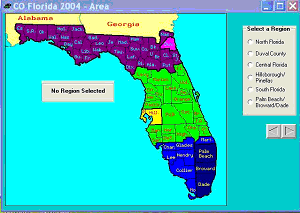FHWA Resource Center
AIR QUALITY TEAM
Success with a Best Practice: Using a Concurrent
"
Worst Case" Scenario Strategy to Assess Carbon
Monoxide Pollutant for Transportation Projects
By: Tianjia Tang and Joon Byun
Air quality analysis is a key part of the planning and design process of a transportation project. One of the most studied air pollutants for a transportation project is carbon monoxide (CO). The reason for this is that CO that results from vehicles operating on a proposed roadway must not contribute to concentrations that violate the National Ambient Air Quality Standard (NAAQS).
Conducting a project level CO analysis is a complex task. It involves running two separate, complicated computer models. The computer models are used to compute motor vehicle emission factors and CO concentrations related to a proposed roadway project. Currently, all States except the State of California use the latest EPA approved motor vehicle emission factor model known as MOBILE6.2. (California adopted its own motor vehicle emission program referred to as EMFAC2002.) All States adopted CAL3QHC models for CO concentration predictions. In addition to the CAL3QHC model, California also adopted the routine use of CALINE4 for all its transportation project evaluations. MOBILE6.2 and EMFAC2002 provide an estimate of how much CO is produced by vehicles in the unit of grams of CO per vehicle mile driven for a given situation. Both MOBILE6 and EMFAC2002 are able to provide emission factors in the unit of grams of CO produced for every hour a vehicle is at idling state. In order to obtain a site and project specific vehicle emission factor, extensive input data related to vehicle fleet, fuel, and environmental conditions must be collected and modeled through the emission factor program. In order to obtain the final CO concentration, data related to roadway geometrics, traffic, meteorology, and receptors - and the just obtained emission factors, must be compiled and run through the dispersion-modeling program. Clearly, the process is complicated and time consuming.
With the development of new vehicle emission technology and the implementation of stringent vehicle emission standards, a majority of CO modeling studies show that transportation projects will not cause violations of CO NAAQS. Most projects pass the CO NAAQS within a large safety margin. In order to efficiently use available resources and reduce time required to conduct a transportation project analysis, State DOT's working with the Federal Highway Administration have been developing alternative methodologies in analyzing the CO issue. One of the outcomes is the development of screening tools by using the so-called concurrent "worst case" scenario strategy. The rationale of this strategy is that if the concurrent "worst-case" scenario does not produce a violation, other cases will not produce violations. By embedding the worst-case data in the screening program, there is no need to collect site-specific meteorological, fleet, and other environmental condition data. Efforts can be concentrated on scenarios that fail the screening test.
Florida Solution
In the early 1990's, the Florida Department of Transportation (FDOT) developed a manual CO screening procedure that was used for all transportation projects. As a Project Development and Environment contract administrator and negotiator at that time, the author experienced a staff time reduction of more than 80% due to the implementation of this manual screening procedure. Recognizing the success of the program, the FDOT converted the manual procedure into a desktop computerized program in the late 1990's. Compared with the manual procedure, the computerized program eliminated the need for having to manually round down traffic speed and round up traffic volume (obtaining a worst case scenario) - a procedure that was occasionally confusing to new practitioners.
At the beginning of 2004, the Environmental Management Office of the FDOT released its latest interim Florida CO Screening Program. According to Mr. Mariano Berrios, the Environmental Programs Administrator for the FDOT, the release incorporates EPA's latest MOBILE6 program. He has noted that the program, "…will be continuously upgraded as the motor vehicle emission actor model is updated."
Mr. Berrios estimates that over the last decade the computerized CO screening program has saved his agency a minimum of 90% staff time on project level CO analysis. At the same time, the screening program has enabled the Department staff to concentrate and spend more time on tackling cases/scenarios that failed the screening test. He praised the FHWA-FL Division and FHWA Resource Center for their, "...continuous support, assistance, and leadership role in the development of the screening program."
Mr. Berrios also noted that, "The FDOT and FHWA work together as one team. We trust each other."
"We want to work with the state DOT to deliver the Federal Aid program in the most efficient way. The development of the Florida CO Screening Program is one example of our Environmental Stewardship. I encourage all Divisions to work with their state partners to develop the tool"
Mr. George Hadley,
FHWA-FL Division's Environmental Program Manager
For more information, contact:
Mariano Berrios
Environmental Programs Administrator
Florida Department of Transportation
605 Suwanee Street, M.S. 37
Tallahassee, FL 32399
Phone: (850) 410-5894
Fax: (850) 410-5808
E-mail: mariano.berrios@dot.state.fl.us.
Dr. Tianjia Tang, PE
FHWA Resource Center
10 South Howard Street, Suite 4000
Baltimore, MD 21201
Phone: (410) 962-2177
Fax: (410) 962-3655
E-mail: tianjia.tang@fhwa.dot.gov.
Florida Success
The Florida CO Screening Program has been developed and updated by researchers from the University of Central Florida and funded by the FDOT. The current program is based on MOBILE6 and CAL3QHC and uses the most conservative (worst-case scenario) assumptions. Major steps involved in the use of the program are illustrated below:
1: Start Screen

2: Project and Analyst Information

3: Air Basin/Location Data

4:Project information

5: Receptor Information

6: Once step 5 is finished, by pressing the Run button, the program will trigger the modeling through both MOBILE6 and CAL3QHC. Final results are created in an easy understandable table.

